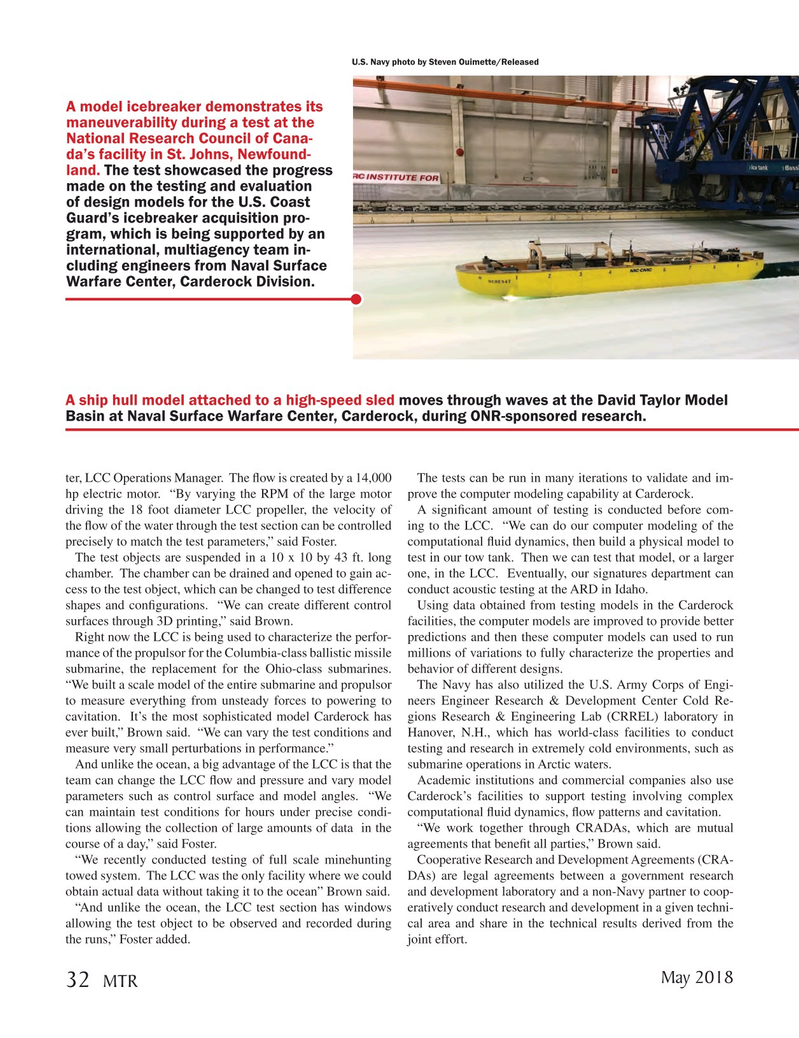
Page 32: of Marine Technology Magazine (May 2018)
Hydrographic Survey: Single beam and Multibeam Sonar
Read this page in Pdf, Flash or Html5 edition of May 2018 Marine Technology Magazine
U.S. Navy photo by Steven Ouimette/Released
A model icebreaker demonstrates its maneuverability during a test at the
National Research Council of Cana- da’s facility in St. Johns, Newfound- land. The test showcased the progress made on the testing and evaluation of design models for the U.S. Coast
Guard’s icebreaker acquisition pro- gram, which is being supported by an international, multiagency team in- cluding engineers from Naval Surface
Warfare Center, Carderock Division.
A ship hull model attached to a high-speed sled moves through waves at the David Taylor Model
Basin at Naval Surface Warfare Center, Carderock, during ONR-sponsored research. ter, LCC Operations Manager. The ? ow is created by a 14,000 The tests can be run in many iterations to validate and im- hp electric motor. “By varying the RPM of the large motor prove the computer modeling capability at Carderock.
driving the 18 foot diameter LCC propeller, the velocity of A signi? cant amount of testing is conducted before com- the ? ow of the water through the test section can be controlled ing to the LCC. “We can do our computer modeling of the precisely to match the test parameters,” said Foster. computational ? uid dynamics, then build a physical model to
The test objects are suspended in a 10 x 10 by 43 ft. long test in our tow tank. Then we can test that model, or a larger chamber. The chamber can be drained and opened to gain ac- one, in the LCC. Eventually, our signatures department can cess to the test object, which can be changed to test difference conduct acoustic testing at the ARD in Idaho.
shapes and con? gurations. “We can create different control Using data obtained from testing models in the Carderock surfaces through 3D printing,” said Brown. facilities, the computer models are improved to provide better
Right now the LCC is being used to characterize the perfor- predictions and then these computer models can used to run mance of the propulsor for the Columbia-class ballistic missile millions of variations to fully characterize the properties and submarine, the replacement for the Ohio-class submarines. behavior of different designs.
“We built a scale model of the entire submarine and propulsor The Navy has also utilized the U.S. Army Corps of Engi- to measure everything from unsteady forces to powering to neers Engineer Research & Development Center Cold Re- cavitation. It’s the most sophisticated model Carderock has gions Research & Engineering Lab (CRREL) laboratory in ever built,” Brown said. “We can vary the test conditions and Hanover, N.H., which has world-class facilities to conduct measure very small perturbations in performance.” testing and research in extremely cold environments, such as
And unlike the ocean, a big advantage of the LCC is that the submarine operations in Arctic waters.
team can change the LCC ? ow and pressure and vary model Academic institutions and commercial companies also use parameters such as control surface and model angles. “We Carderock’s facilities to support testing involving complex can maintain test conditions for hours under precise condi- computational ? uid dynamics, ? ow patterns and cavitation. tions allowing the collection of large amounts of data in the “We work together through CRADAs, which are mutual course of a day,” said Foster. agreements that bene? t all parties,” Brown said.
“We recently conducted testing of full scale minehunting Cooperative Research and Development Agreements (CRA- towed system. The LCC was the only facility where we could DAs) are legal agreements between a government research obtain actual data without taking it to the ocean” Brown said. and development laboratory and a non-Navy partner to coop- “And unlike the ocean, the LCC test section has windows eratively conduct research and development in a given techni- allowing the test object to be observed and recorded during cal area and share in the technical results derived from the the runs,” Foster added. joint effort.
May 2018 32 MTR
MTR #4 (18-33).indd 32 MTR #4 (18-33).indd 32 5/10/2018 8:59:45 AM5/10/2018 8:59:45 AM

 31
31

 33
33
